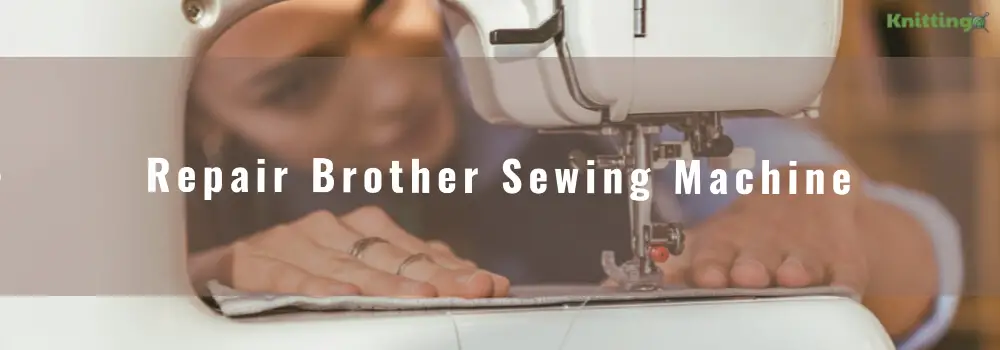It’s challenging to work with brother sewing machines with problems like bent/blunt needles, thread bunching under the fabric, etc. Even far worse if you have lost your operational manual and you are unable to solve issues. Interestingly, you can resolve these problems without hiring an expert. We have compiled a list of common sewing problems and a step-by-step explanation on how to fix them.
Repair Of The Brother Sewing Machine With Thread Bunching Issues
A common issue that faces Brother and other sewing machines is thread bunching under the fabric.
For repair, follow these steps:
Step 1: Raise the presser foot lifter first and rethread the machine top thread. This opens up the tension system to obtain the yarn.
Step 2: Lift the take-up lever and needle to your machine manuals’ maximum position, i.e., 3 or 4 for brother sewing machines. All this will assist you in confirming the correct tension.
Common Problems With Brother Sewing Machines And Solution
| Other Common Problems | Solutions |
| Broken, bent, or blunt needle | Ensure you have a new and the right type of needle for each project you’re handling |
| Fabric not feeding | Make sure your pressure foot is down and set to the right pressure regarding your fabric. |
| Stitch forms loops in between | Ensure your machine is threaded properly and stitch tension adjusted. |
| Thread keeps breaking | Use the correct type of thread. |
How Do I Fix My Brother’s Sewing Machine That Won’t Sew?
Various causes can lead to your Brother’s sewing machine not sewing. Follows the steps below to determine the cause of your machine problem, especially if it’s not making a stitch, and find the solution.
Step 1: Check your machine top thread if it’s threaded correctly and rethread properly.
Step 2: Ensure the needle thread at the back of the needle bar thread controls the needle pole.
Step 3: Check the thread if it’s tangled and knotted. In case the yarn is tangled, cut it and remove it from the bobbin surface.
Step 4: Make sure the thread is not too thick for your needle by checking your table of fabric, needle, thread combinations. Then choose the correct combination of needle and thread you are going to use.
Step 5: Check if the upper thread tension is too tight. When it’s too fitted, adjust your top thread tension accordingly.
Step 6: Check your machine needle if it’s blunt at the end of its bent. If this is the cause, make arrangements and replace the needle.
Step 7: Check your sewing machine needle hole. Ensure there are no scratches in the hole area in your machine needle plate.
Step 8: Check your machine presser foot. Ensure there are no scratches everywhere in the presser foot. Also, ensure you are using the correct presser foot for the stitch that you need to sew.
Step 9: Check your bobbin and ensure it’s inserted correctly. To check, insert it into the inner rotary hook to make its bottom flat with the thread behind your machine bobbin spring of its internal rotary hook.
Step 10: Ensure there are no scratches on your machine bobbin. If there is, then it’s about time you replace that bobbin.
Why Is My Brother Sewing Machine Jamming?
Your sewing machine could be jamming due to various reasons. One of its reasons might be a dirty throat plate. That means you need to remove it and see underneath and check if lint plus other hindrance has managed their way inside and jammed the machine in the process. The other reasons might be;
1. Your machine’s upper thread may be tangled. To fix it, remove the yarn fully from your machine. Use the correct size spool cap for your machine size of the strand. Then rethread your machine in regards to its manual directions. You can refer to “Upper threading” of preparation in your manual category.
2. Please take out the bobbin and ensure it is threaded correctly in the shuttle race. Loose threads or lint in your machine shuttle race needs to be removed.
3. Your machine tension is too loose or too tight. You can decide to adjust your tightness manually or set it up according to your machine’s basic thread tension.
4. Incorrect combination of the needle size, fabric, and thread size. To avoid this problem, always use the correct combination of needle size, fabric type, and the thread size you are sewing, e.g., you need 16 needles and 40-50 heavy-duty thread for denim size.
If you could not unjam your sewing machine, take it to an approved brother repairer around your place and let professionals handle the issue. They need to check several parts, as it might have complicated repair that you might not be able to DIY.
Is It Worth Repairing A Sewing Machine?
There has been an ongoing debate on whether it is worth repairing a sewing machine instead of replacing it. For us, we say it depends on many factors. We see people repairing their appliance at high cost than purchasing a new one because they are unwilling to let go. Since they are very significant to them, it links their family or is simply a family heirloom.
You need to face reality and make a suitable decision whether it’s time to replace it or repair it. Consider these factors before making your decision.
Factors To Consider Before Repairing A Sewing Machine
Cost
You have to consider the cost of repairing the machine and purchasing a new one. This is especially if you have been using your appliance and don’t have a warranty. If the cost is almost similar, it’s better to get a new and upgraded one. Unless the features you are looking for are out of the market, then replacement would be worth it.
The Value Of Your Machine
If it cost you a lot of money to get your sewing model, then paying a small amount for repair will be the better option. It’s advisable to repair your machine if the cost doesn’t exceed 75% of the original price.
Condition Of Your Sewing Machine
If you have been maintaining your machine, it will be easier to repair. However, if it is aging and in poor condition, it will be great to purchase a new one instead of wasting your money on repairs.
Your Projects And The Type Of Your Fabric
Sometimes it’s better to repair your old model that handles heavy fabric other than purchasing a new one that will not do the intended work.
Are You Willing To Relearn The Sewing Operation, Setting, And So On?
If you have gotten used to your old sewing machine, it might not be easier for you to start again. The new models are very different to operate and might take you time to learn. In such a case repairing will be better.
Materials Used To Make Your Sewing Machine
The construction material is another factor you need to consider. If your model is made from cheap plastic, it may not be worth your time, trouble, and money to repair them. Rather, it will be a good idea to invest in a new quality machine.
How Do I Service My Brother’s Sewing Machine?
Some of the older machines were indestructible and more durable than the newly cheaper ones made from plastic parts. Nevertheless, you can extend the effectiveness and life of sewing machines with maintenance. Follow these steps if you need to service your brother sewing machine;
Step 1: Removing Dust And Fluff
Remove any dust and fluff in your machine whenever you find it especially feed dogs. You can use a brush, vacuum cleaner, or a can of compressed air or blow. However, there is a risk of blowing the fluff further into the system. Replace the foot and normalize using good quality threads that shed less fuzz.
Step 2: Checking The Bobbin
Remove the bobbin from its case holder, separate it from the case, and blow out any dust. The bobbin case usually fits well into its case holder that rotates as the machine operates.
Be careful; the bobbin case holder has a sharp point called the hook designed to catch the upper thread while engaging its lower yarn to make a stitch. Ensure all the bobbins that come out in a second-hand machine are of the right sort since the wrong one will cause many problems if they work at all.
Step 3: Lubrication
To lubricate your machine, use only sewing machine oil and apply more drops to each bearing or connection. Apply thoroughly and leave it for a while to allow oil to penetrate. Repeat the process if need be until it operates smoothly.
Step 4: Checking The Tension
Check bobbin tension carefully and avoid poor results, plus snagging or broken thread. The tightness is well adjusted if it’s enough to support the weight of the bobbin and case. Shaking it will unwind little yarns, then adjust it with a screw in the tension spring.
Step 5: Check The Bobbin Winder
Check your sewing machine bobbin winder carefully. If its tyre is cracked or worn out, replace it.
Step 6: Check The Electrics
Make sure your electric machine isn’t plugged in while at the same time touching its electric parts. New models nowadays have electronic speed control like the dimmer switch. Ensure it’s working well as it should.
Step 7: Check The Timing
When you are getting regularly broken threads, it might be your timing needs adjustments. You may need to ask for help from an expert sewing machine repairer.
What Does Error 6 Mean On A Brother Sewing Machine?
Error 6 is usually shown if the motor locks up because of a tangle thread problem or other reasons. To fix it, clean the race to remove any tangled thread. Afterward, insert the bobbin case correctly. In case the needle is broken or bent, replace it and continue with your work.
Conclusion
Whether you repair your old sewing machine or purchase a new one, its effectiveness and efficiency will depend on its maintenance. Some common issues can be fixed without additional cost, with some repairs costing much compared to buying a new one. You need to check the price, condition of your machine, intended projects, and materials used in construction before deciding on the way forward. Nonetheless, it would help if you serviced your appliance once a year to keep it in its best working condition. Note that repair costs might be around $ 75 to $ 100 that can be avoided by proper maintenance. However, if you notice any problem that is not within your limit, don’t hesitate to ask for professional help.

